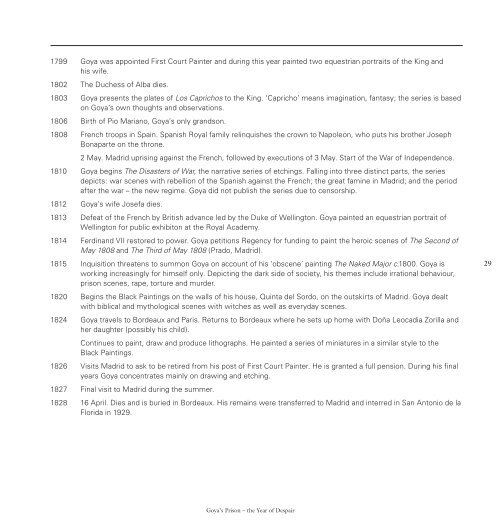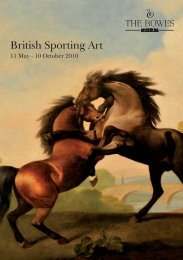You also want an ePaper? Increase the reach of your titles
YUMPU automatically turns print PDFs into web optimized ePapers that Google loves.
1799 Goya was appointed First Court Painter and during this year painted two equestrian portraits of the King and<br />
his wife.<br />
1802 The Duchess of Alba dies.<br />
1803 Goya presents the plates of Los Caprichos to the King. ‘Capricho’ means imagination, fantasy; the series is based<br />
on Goya’s own thoughts and observations.<br />
1806 Birth of Pio Mariano, Goya’s only grandson.<br />
1808 French troops in Spain. Spanish Royal family relinquishes the crown to Napoleon, who puts his brother Joseph<br />
Bonaparte on the throne.<br />
2 May. Madrid uprising against the French, followed by executions of 3 May. Start of the War of Independence.<br />
1810 Goya begins The Disasters of War, the narrative series of etchings. Falling into three distinct parts, the series<br />
depicts: war scenes with rebellion of the Spanish against the French; the great famine in Madrid; and the period<br />
after the war – the new regime. Goya did not publish the series due to censorship.<br />
1812 Goya’s wife Josefa dies.<br />
1813 Defeat of the French by British advance led by the Duke of Wellington. Goya painted an equestrian portrait of<br />
Wellington for public exhibiton at the Royal Academy.<br />
1814 Ferdinand VII restored to power. Goya petitions Regency for funding to paint the heroic scenes of The Second of<br />
May 1808 and The Third of May 1808 (Prado, Madrid).<br />
1815 Inquisition threatens to summon Goya on account of his ‘obscene’ painting The Naked Major c.1800. Goya is<br />
working increasingly for himself only. Depicting the dark side of society, his themes include irrational behaviour,<br />
prison scenes, rape, torture and murder.<br />
1820 Begins the Black Paintings on the walls of his house, Quinta del Sordo, on the outskirts of Madrid. Goya dealt<br />
with biblical and mythological scenes with witches as well as everyday scenes.<br />
1824 Goya travels to Bordeaux and Paris. Returns to Bordeaux where he sets up home with Doña Leocadia Zorilla and<br />
her daughter (possibly his child).<br />
Continues to paint, draw and produce lithographs. He painted a series of miniatures in a similar style to the<br />
Black Paintings.<br />
1826 Visits Madrid to ask to be retired from his post of First Court Painter. He is granted a full pension. During his final<br />
years Goya concentrates mainly on drawing and etching.<br />
1827 Final visit to Madrid during the summer.<br />
1828 16 April. Dies and is buried in Bordeaux. His remains were transferred to Madrid and interred in San Antonio de la<br />
Florida in 1929.<br />
29<br />
Goya’s <strong>Prison</strong> – the Year of Despair






